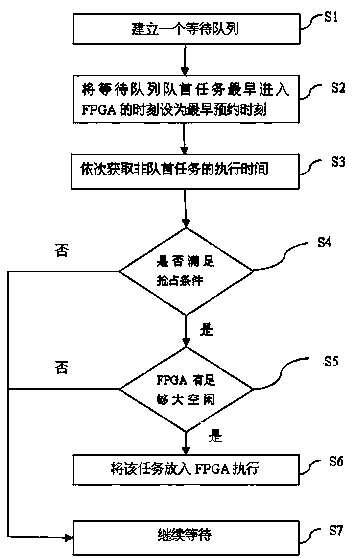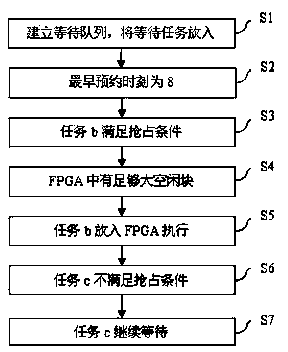FPGA task scheduling method based on condition preemption
A task scheduling and task technology, applied in the direction of multi-programming devices, etc., can solve the problem of high complexity, achieve the effect of low scheduling complexity and reduce waiting time
- Summary
- Abstract
- Description
- Claims
- Application Information
AI Technical Summary
Problems solved by technology
Method used
Image
Examples
Embodiment Construction
[0022] Such as figure 1 Shown, the specific implementation steps of the method of the present invention are as follows:
[0023] 1) Create a waiting queue, which is used to place tasks waiting to enter the FPGA;
[0024] 2) Set the time when the head task of the waiting queue first enters the FPGA as the earliest reservation time;
[0025] 3) Obtain non-team leader tasks sequentially, and obtain their execution time;
[0026] 4) Judging whether they meet the preemption condition: current time + task execution time ≤ earliest reservation time of the team leader task. If it is satisfied, skip to 5), if not, skip to 7);
[0027] 5) Judging whether there is enough free space in the FPGA at this moment to allow the task to be placed, if so, skip to 6), otherwise skip to 7);
[0028] 6) The task is put into the FPGA for execution prior to the team leader task;
[0029] 7) The task continues to wait.
[0030] Such as figure 2 As shown, an example of an FPGA task scheduling me...
PUM
 Login to View More
Login to View More Abstract
Description
Claims
Application Information
 Login to View More
Login to View More - R&D
- Intellectual Property
- Life Sciences
- Materials
- Tech Scout
- Unparalleled Data Quality
- Higher Quality Content
- 60% Fewer Hallucinations
Browse by: Latest US Patents, China's latest patents, Technical Efficacy Thesaurus, Application Domain, Technology Topic, Popular Technical Reports.
© 2025 PatSnap. All rights reserved.Legal|Privacy policy|Modern Slavery Act Transparency Statement|Sitemap|About US| Contact US: help@patsnap.com


